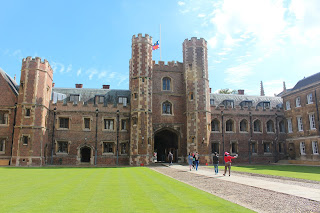We spent
the week visiting buildings built or rebuilt in the Elizabethan era, from the
grandeur of Hardwick Hall to Anne Hathaway’s cottage. Both of those are fairly
well known and frequently visited. Indeed, I had visited both several decades
ago.
New to my eyes was Kirby Hall in
Lincolnshire, built by a gentleman named Henry Stafford, then purchased by Sir
Christopher Hatton, one of Queen E’s favorite courtiers. Its story, like that
of Wollaton Hall in Nottingham, and Hardwick Hall, was that the owner built or
expanded the house not only to impress everyone, but in hopes that Queen
Elizabeth would stay with them during one of her summer progresses. In all
three cases, she did not visit, and the expense of building left the owners in
debt. It is partially in ruins, but the bay windows and the garden are its
knockout features.

The jewel to my mind was Little
Moreton Hall, in Cheshire. Built and extended at various times during the 16th
century, it had the good fortune not to remain in the same family throughout
the following centuries. Why? Because
the noble families who owned Burghley House and Hardwick Hall looked around in
1680 or so and said to themselves, “This room is soooo last century. Let’s tear
out all this linen fold paneling and hire an Italian artist to paint the walls
and ceiling with allegorical scenes of us cavorting with the Roman gods.” And the
same thing happened in the 18th century. Then indoor plumbing, gas
lights, and electricity was installed. Or the family tore down the entire
building and erected a Palladian-inspired house. Or they went broke and the
building fell to ruins.
On the contrary, Little Moreton
Hall was abandoned by the Moretons, but rented out to a tenant farmer, who
lived in parts of it, while storing equipment, hay, and such in the rest. The result is a fairly intact 16th
century gentry manor house.
For my purposes, Edward Hunter was
much more likely to have grown up in a house like this, and visited similar,
than to be invited to the prodigy houses like Wollaton and Hardwick. In Little
Morton I also found a doublet I thought suited me well.
We are spending the weekend in
Somerton with mystery writer Paula Gosling and her husband John.











